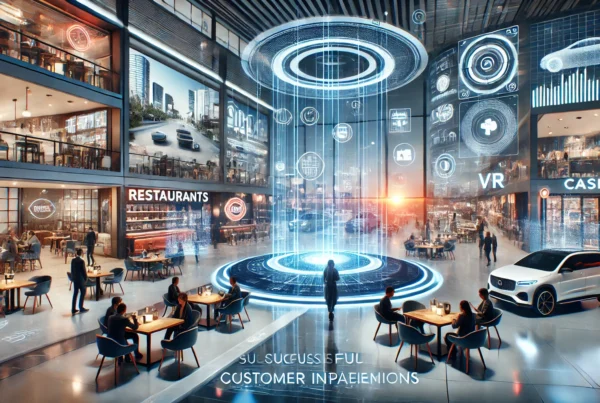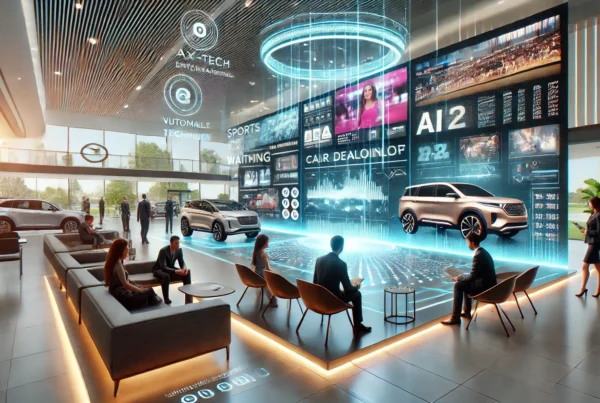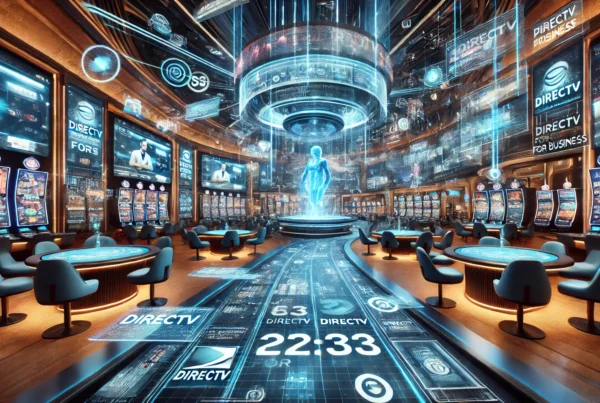In today’s fast-paced digital landscape, businesses across industries are discovering that traditional customer engagement strategies are no longer enough. As we approach 2025, the need for innovative strategies for enhancing customer engagement has never been more critical. Whether you’re in the hospitality, gaming, auto, or private office sector, understanding and implementing cutting-edge techniques can set your business apart from the competition.
Why is customer engagement so vital? It’s simple: engaged customers are loyal customers. According to a report by PWC, 61% of executives believe that customer loyalty has increased post-pandemic, yet only 20% of customers agree. This disconnect highlights the importance of truly understanding and meeting your customers’ needs. By leveraging the latest trends and technologies, businesses can create memorable experiences that resonate with their audience and foster lasting relationships.
At Sports Direct, we understand the unique challenges faced by business owners and decision-makers in the hospitality, gaming, and auto industries. Our mission is to provide commercial video programming solutions that enhance the on-premise entertainment experience, ultimately boosting customer satisfaction and loyalty. In this blog post, we’ll explore the most effective strategies for enhancing customer engagement in 2025, from personalized interactions to leveraging cutting-edge technologies.
Are you ready to transform your customer engagement strategy? Join us as we delve into the essential techniques that will captivate your audience and drive success. Let’s dive into the future of customer engagement and discover how you can stay ahead of the curve.
Personalization: The Key to Customer Connection
In the ever-evolving landscape of customer engagement, personalization stands out as a pivotal strategy for businesses aiming to connect deeply with their audience. By tailoring interactions and experiences to individual preferences, companies can foster meaningful connections that resonate with customers. This approach not only enhances customer satisfaction but also drives loyalty and retention, crucial elements for any business looking to thrive in 2025.
Competitors like Outreach and Sprinklr have demonstrated the power of personalized communication and content. They emphasize the importance of understanding customer needs and preferences to deliver customized experiences that make each customer feel valued and understood. Leveraging data analytics and AI, businesses can elevate their personalization efforts, ensuring that every interaction is relevant and impactful.
Successful Personalization Strategies
Implementing successful personalization strategies can significantly enhance customer engagement. Here are some proven techniques:
- Targeted Email Campaigns: Crafting emails that address the specific needs and interests of customers can lead to higher open rates and conversions. For example, segmenting your audience based on past purchases or browsing behavior allows for more relevant messaging.
- Personalized Product Recommendations: By analyzing customer data, businesses can suggest products that align with individual preferences, increasing the likelihood of purchase. This strategy is particularly effective in e-commerce, where tailored recommendations can drive sales.
- Customized Content: Delivering content that speaks directly to the customer’s interests and challenges can build trust and authority. This might include personalized blog posts, videos, or webinars that address specific pain points.
The Role of AI in Enhancing Personalization
Artificial Intelligence (AI) plays a crucial role in scaling personalization efforts. AI-powered tools can process vast amounts of data to uncover insights about customer behavior and preferences, enabling businesses to deliver more tailored experiences. For instance, AI can automate the personalization of marketing messages, ensuring they are timely and relevant.
Moreover, AI-driven chatbots can provide personalized customer support by understanding and predicting customer needs in real-time. This not only enhances the customer experience but also allows businesses to efficiently manage customer interactions at scale.
Case Studies: Competitors’ Success with Personalization
Several companies have successfully harnessed personalization to boost customer engagement. Outreach, for example, uses personalized communication strategies to increase conversion rates and customer loyalty. By leveraging data analytics, they tailor their messaging to meet the specific needs of each customer segment.
Similarly, Sprinklr has implemented personalized customer service solutions that enhance customer satisfaction. Their approach involves using AI to analyze customer interactions and provide insights that inform personalized engagement strategies. This has resulted in improved customer retention and brand loyalty.
As businesses look to the future, embracing personalization as a core component of their customer engagement strategy will be essential. By leveraging the power of data and AI, companies can create experiences that not only meet but exceed customer expectations, paving the way for lasting connections and business success.
Harnessing Technology for Enhanced Engagement
In the quest for innovative strategies for enhancing customer engagement, technology emerges as a pivotal ally. As businesses strive to connect more deeply with their customers, the integration of cutting-edge technologies becomes not just advantageous but essential. From AI-driven chatbots to immersive virtual experiences, companies are leveraging these tools to create meaningful interactions that resonate with their audience. Competitors like Sprinklr and Highspot exemplify the importance of embedding technology into engagement strategies, showcasing how digital tools can transform customer experiences.
In this section, we’ll explore various technologies that are reshaping customer engagement landscapes. We’ll delve into how businesses are successfully implementing these technologies to foster connections and drive loyalty. Let’s uncover the potential of these innovations and how they can be harnessed to captivate and delight customers in 2025.
AI-Driven Chatbots: Revolutionizing Customer Support
AI-driven chatbots have become a cornerstone of modern customer service, offering 24/7 support and personalized interactions. These intelligent systems can handle routine inquiries, freeing up human agents to tackle more complex issues. By utilizing natural language processing, chatbots can understand and respond to customer queries in real-time, enhancing the overall customer experience.
Companies like Sprinklr have integrated AI chatbots into their customer service platforms, allowing for seamless interactions across multiple channels. This approach not only improves response times but also ensures consistency in customer service, fostering trust and satisfaction.
Immersive Virtual Reality Experiences
Virtual reality (VR) is transforming the way businesses engage with customers, offering immersive experiences that captivate and delight. VR allows customers to interact with products and services in a virtual environment, providing a deeper understanding and connection.
For instance, in the auto industry, VR can be used to offer virtual test drives, allowing potential buyers to experience vehicles without leaving their homes. This not only enhances customer engagement but also provides a unique selling proposition that sets businesses apart from competitors.
Mobile Apps: Enhancing Accessibility and Engagement
Mobile apps continue to be a powerful tool for customer engagement, offering convenience and personalized experiences at the fingertips of users. These apps can provide tailored content, exclusive offers, and seamless communication channels, all of which contribute to a more engaging customer journey.
Highspot, for example, utilizes mobile apps to deliver personalized content and resources to their users, ensuring that they have access to the information they need, when they need it. This approach not only enhances user satisfaction but also encourages ongoing engagement and loyalty.
- AI-Driven Chatbots: Provide instant customer support and personalized interactions.
- Virtual Reality: Offer immersive experiences that enhance product understanding and connection.
- Mobile Apps: Deliver personalized content and seamless communication.
As we move towards 2025, the integration of these technologies into customer engagement strategies will be crucial for businesses looking to stay ahead. By embracing these innovations, companies can create memorable experiences that not only meet but exceed customer expectations, paving the way for lasting relationships and business success.
Feedback and Community Building
In the rapidly evolving business landscape, innovative strategies for enhancing customer engagement are essential for staying ahead. A crucial component of these strategies is the integration of customer feedback and community building. By actively listening to customers and fostering a sense of community, businesses can significantly boost engagement and loyalty.
Competitors like Sprinklr and Outreach have demonstrated the power of leveraging customer feedback to create a community-centric approach. They emphasize the importance of understanding customer needs and preferences to deliver experiences that resonate deeply with audiences. Let’s explore how you can implement these strategies effectively.
Collecting and Utilizing Customer Feedback
Collecting customer feedback is the first step in understanding and meeting customer expectations. Businesses can employ various methods to gather insights, such as surveys, social media interactions, and direct customer conversations. This data serves as a foundation for refining products and services.
Once collected, feedback should be analyzed and acted upon promptly. Implementing changes based on customer input demonstrates that you value their opinions, fostering trust and loyalty. For example, Outreach uses customer feedback to tailor their engagement strategies, ensuring they align with customer needs and preferences.
The Role of Community-Building Initiatives
Building a community around your brand can significantly enhance customer engagement. Community-building initiatives create a sense of belonging and encourage customers to become brand advocates. Companies like Sprinklr have successfully created vibrant online communities where customers can share experiences and provide peer support.
These communities not only facilitate customer interaction but also provide valuable insights into customer sentiment and trends. By engaging with these communities, businesses can stay attuned to customer needs and foster a collaborative environment that encourages loyalty.
Industry Insights on Feedback and Community
Industry leaders highlight the importance of feedback and community in driving customer engagement. According to a recent study, companies that actively engage with their communities see a 20% increase in customer retention. This underscores the value of creating a feedback loop where customers feel heard and valued.
Quotes from industry experts further emphasize this point. A leading figure in customer engagement states, “Building a community around your brand is not just about engagement; it’s about creating a space where customers feel connected and valued.” Such insights reinforce the need for businesses to prioritize feedback and community-building as core components of their engagement strategies.
By integrating customer feedback and fostering community, businesses can create a dynamic and engaging environment that not only meets but exceeds customer expectations. This approach not only enhances customer satisfaction but also drives long-term loyalty and business success.
Empowering Customer Engagement for Future Success
As we look towards 2025, it becomes increasingly clear that innovative strategies for enhancing customer engagement are not just beneficial—they are essential for businesses aiming to thrive in a competitive landscape. The key lies in embracing personalization, leveraging technology, and building strong community connections. By doing so, businesses can foster customer loyalty, drive satisfaction, and ensure long-term success.
To recap, personalization is the cornerstone of effective engagement. By tailoring interactions and recommendations to individual customer preferences, businesses can create a sense of value and connection. This approach, supported by AI and data analytics, ensures that every customer interaction is meaningful and relevant. Moreover, the integration of cutting-edge technologies such as AI-driven chatbots and VR experiences can revolutionize customer support and engagement, offering innovative ways to interact and connect with your audience.
- Personalized Interactions: Utilize data to tailor customer experiences and increase satisfaction.
- Technological Integration: Implement AI and VR to enhance engagement and customer support.
- Community Building: Foster a sense of belonging and encourage customer loyalty through active community engagement.
As you consider implementing these strategies, reflect on how they can fit into your current business model. What steps can you take today to begin transforming your customer engagement approach? Remember, the journey towards enhanced engagement is ongoing, requiring continual adaptation and innovation.
We invite you to explore more resources on our website to further enhance your understanding and application of these strategies. Let’s work together to captivate and delight your customers, paving the way for a successful future.








